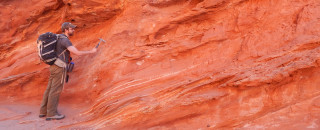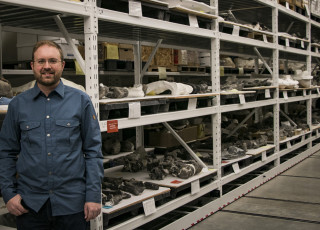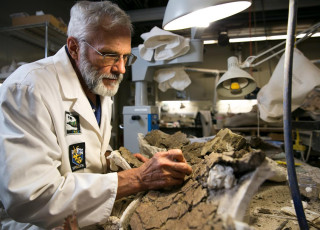Dr. Randy Irmis Receives Fulbright Fellowship for Collaborative Research in Argentina
As a 2023 Fulbright U.S. Scholar Fellow, NHMU’s Dr. Randy Irmis will head to Argentina in early 2024 for six months as part of the sabbatical he’s taking for the 2023-2024 academic year. This work continues his long-term research collaboration with Argentine colleagues to study the evolution of ecosystems and paleoclimate during the Triassic Period, between 252-201 million years ago. He’ll be hosted by the Instituto Argentino de Nivología Glaciología y Ciencias Ambientales (IANIGLA) in the city of Mendoza.
While there, he’ll work with colleagues to develop and teach a field course focusing on how to use the geologic record to interpret how ecosystems on land changed in response to climate changes in deep time, using local geologic archives from Triassic Period.
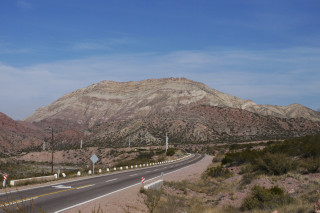
Triassic rocks near Mendoza. Image by Randy Irmis
“There are great Triassic outcrops that are very accessible near the city of Mendoza that we can use to investigate and interpret ancient ecosystems,” Irmis says. “So, we will have a natural laboratory to teach this course.”
The sabbatical is a continuation of more than 15 years of research in Argentina that Irmis began as a student at the University of California, Berkeley in 2005. Why Argentina?
“The country has a really rich archive of sedimentary rocks that provide insight into what the climate and environment was like during the Triassic, but also a lot of fossils in those rocks, including the earliest dinosaurs, that reveal what sort of plants and animals were living during that time,” said Irmis.
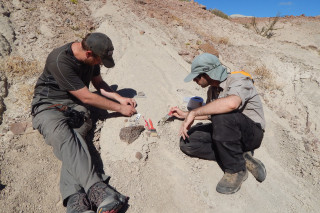
Randy Irmis, left, and Lean dro Gaetano excavate a fossil in the field in Argentina. Image by Adriana Mancuso
He says that Argentina provides a nice counterpoint to his stateside work in the western U.S. because there are a great deal of rocks of similar age in the Intermountain West and Argentina. The difference is that the Triassic sediments in the U.S. were deposited very close to the equator, providing a tropical low-latitude view. But Triassic rocks in Argentina are from the mid-latitudes, about 10-15° further south than they are today.
The Triassic is an incredibly dynamic time in Earth’s history. Many animal groups typical in today’s ecosystems on land have their origins in the Triassic, and there are a lot of firsts.
“The first mammals show up during this time, also the first frogs and salamanders, the first lizards, and then the first dinosaurs, which eventually evolve into birds,” Irmis says. “It’s a pretty amazing time as a case study because of everything that happened.”
He goes on to explain that the Triassic is ‘bookended’ by two mass extinction events, the end-Permian mass extinction about 252 million years ago and then the end-Triassic extinction 201 million years ago, both of which were caused by gigantic volcanic eruptions; think of long narrow fissures spewing lava everywhere, instead of individual volcanoes erupting.
The amount of greenhouse gasses generated by both eruptions created runaway global warming, not unlike what the Earth could be headed towards now. The eruptions during the end-Triassic mass extinction basically tripled the amount of carbon dioxide in the atmosphere in a few 1000 years.
“But the rate of carbon dioxide release now is double what it was 200 million years ago even if the volume isn’t as large,” says Dr. Irmis soberly. “So, we study the Triassic in part because it helps us better understand how ecosystems recover from one mass extinction, their lead up to the next mass extinction, what adapts and survives versus what goes extinct,” he adds. “It gives you so much more of a complete picture of life on Earth.”
Irmis says this is just one modest example of how scientific discoveries made by NHMU’s entire Collections & Research department science staff can provide insights into the challenges and opportunities we face today as a global society.
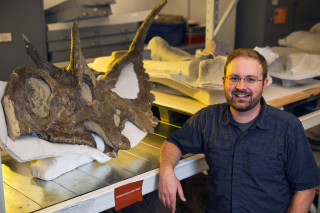
Randy Irmis in the paleontology collections at NHMU. Image by Mark Johnston
For the last six years, he’s been the Collections & Research Department’s biggest advocate as Chief Curator, in addition to his role as Curator of Paleontology, and Associate Professor of Geology & Geophysics at the University of Utah. As he rotates off the Chief Curator role – as is the practice – we asked him about museum curation, and what a Chief Curator does.
According to Randy, a curator is a PhD-level scientist who does original scientific research that involves new or existing museum collections and collaborates across the museum to share those scientific stories through publications, exhibitions, and public announcements. Check out Randy’s published research on how fossils in Triassic Argentina reveal how climate change affected life in the time of dinosaurs.
Chief Curators have additional administrative and strategic layers to their work. As NHMU’s Chief Curator, Randy represented the Collections & Research Department with other museum leadership and contributed to the growth and sustainability for the Museum. Though Randy’s the first to tell you he doesn’t deserve too much credit, and that he’s excited for Dr. Tyler Faith to assume the Chief Curator role – more on that soon.
Reflecting on his time as Chief Curator, Randy considers the two most tangible strategic goals have been to increase the size of NHMU’s scientific staff by four curators and two collections staff members and establishing the Sustaining Biodiversity Research Cluster at the Museum, as well as prioritizing and making great progress on the digitization of NHMU collections.
“It’s been amazing to see the C & R team grow, not only in terms of curators, but additional Collections Managers and Digitization staff as well, all of which are critical to ensuring the future for NHMU,” he says.
Irmis explains that as a state institution whose collections mostly come from public lands, it is our duty to share the collections with our public stakeholders. “Digitization is a great way to do that, especially for folks who may never be able to visit the museum in person,” he says.
NHMU collections digitization coordinator Alyson Wilkins, her team, and our collections managers have done an incredible job over the past 5 years making our collections more accessible to world.”
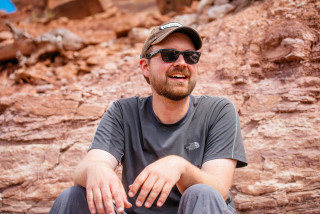
Randy Irmis takes a break while working in the Dystrophaeus quarry in the Utah desert. Image by Jeremiah Watt
Another example Randy offers to underscore the relevance of Utah’s natural history today and in the future comes from NHMU’s Vertebrate Zoology division. Curator Dr. Eric Rickart had a long-term program going back to areas to survey rodents that were surveyed by museums 50 or 100 years ago. He and his team are re-surveying them in the same way, testing changes and observing distinct changes. The hiring of Collections Manager Katrina Derieg (now at the University of Montana) in 2020 added a new dimension to this research program, including investigation of genetic changes and those of parasites preserved within these small mammals.
“Museum voucher specimens – those they collect in the field and add to NHMU collections – allow Eric and Katrina to observe whether there are changes through time,” Randy explains, “which give concrete insights on climate change, species evolution, and effects of human land use.”
Stay tuned for more from Collections and Research at the Natural History Museum of Utah, as well as an introduction to our new Chief Curator, Dr. Tyler Faith.
